Grade 8 • Study Guide
Life Orientation
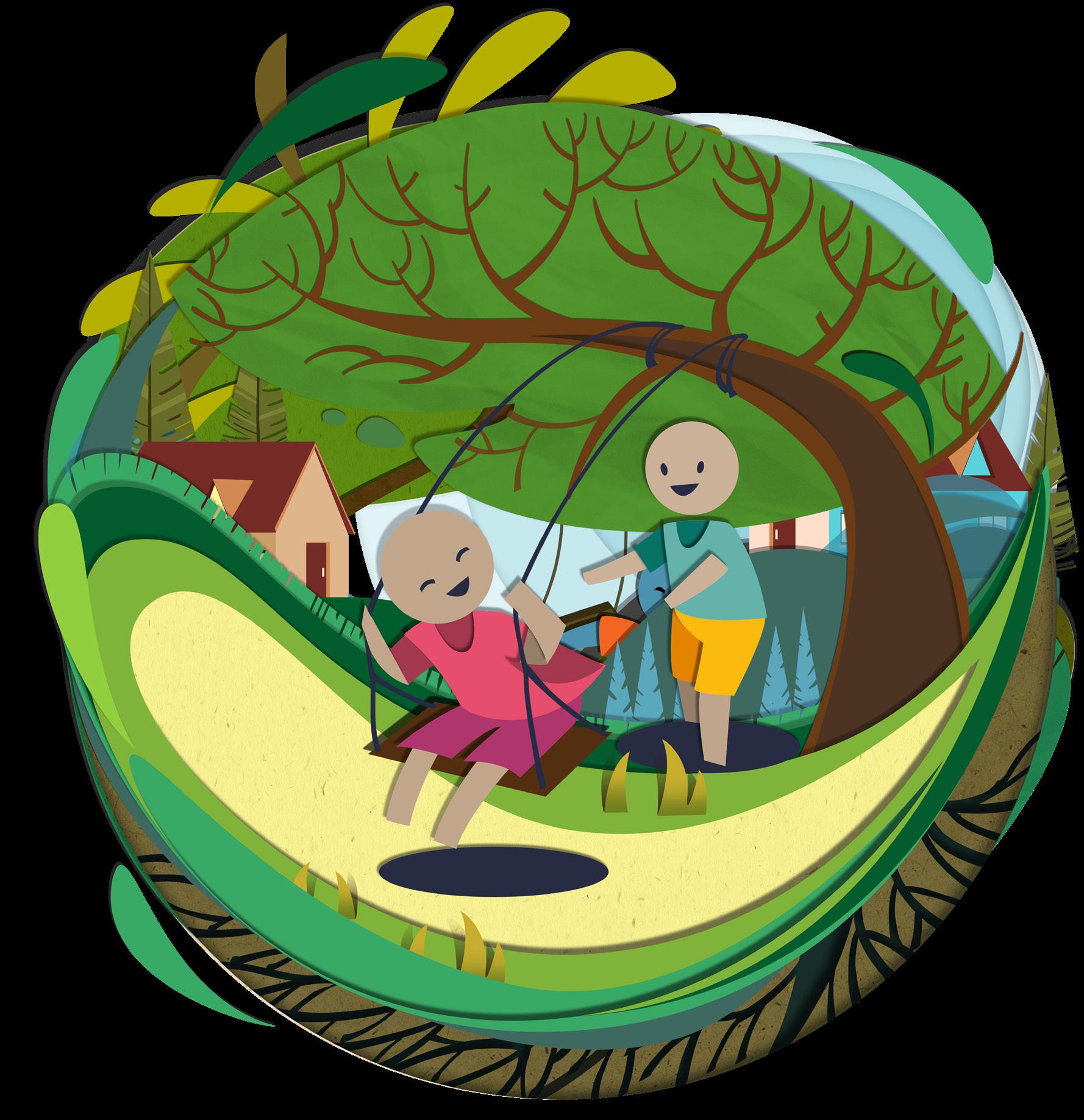
Owned and published by Optimi, a division of Optimi Central Services (Pty) Ltd.
7 Impala Avenue, Doringkloof, Centurion, 0157 info@optimi.co.za www.optimi.co.za
© Optimi
Apart from any fair dealing for the purpose of research, criticism or review as permitted in terms of the Copyright Act, no part of this publication may be reproduced, distributed, or transmitted in any form or by any means, electronic or mechanical, including photocopying, recording, or any information storage and retrieval system without prior written permission from the publisher.
The publisher has no responsibility for the persistence or accuracy of URLs for external or third-party internet websites referred to in this publication, and does not guarantee that any content on such websites is, or will remain, accurate or appropriate.
There are instances where we have been unable to trace or contact the copyright holder. If notified, the publisher will be pleased to rectify any errors or omissions at the earliest opportunity.
Reg. No.: 2011/011959/07

Study Guide
Grade 8

PREFACE
Introduction
Life Orientation plays a vital role in your development as a person. It helps you to get to know yourself better, it teaches you how the world works and where you fit in. You will learn how to take responsibility, solve problems, make good decisions and live a healthy life.
All learning materials comply with the CAPS requirements. The practical section of Life Orientation, called Physical Education, is covered at the beginning of each unit. You must spend at least one hour each week on Physical Education.
Every lesson has subsections. You must complete the activities and exercises at the end of each lesson to prepare for exams and tests. It will give you an indication of whether you have mastered the work.
Assessment plan and requirements
Assessment is a continuous process to monitor your progress. Life Orientation requires certain skills such as decision-making, communication, self-assertion, negotiation, goal-setting, problem-solving and creative thinking. You will be assessed as follows:
1. Informal assessment
• This takes place during the teaching and learning process.
• It is usually an activity you must complete at the end of a lesson.
• Informal assessment results are not recorded.
2. Formal assessment
• All assessment tasks that form part of the formal assessment programme for the year are considered formal assessment.
• Activities in the Study Guide do not form part of the formal assessment. Please refer to the portfolio book for all formal assessments.
Study tips and methods
Do not put off studying until the night before a test or exam. It is never too late to develop good study habits. Every person’s level of motivation differs and some learners are naturally more motivated to study than others. In much the same way athletes must practise, so too efficient study skills must be practised to achieve success. The sooner you learn and apply good study methods, the easier tests and exams will become, and the greater your chance of getting good marks.
Tips to help you make the most of Life Orientation studies:
• You can study anywhere, but the location should not have any distractions.
SAMPLE
• Time is your most precious resource. If you cannot find the time to study, you should prioritise and draw up a timetable.
• When preparing for tests or exams, make time for revision. Do this while the work is still fresh in your memory. If you wait too long, the content may not make sense anymore.
• Make sure you understand the learning material in your Study Guide. Memorising facts is useless if you do not understand it.
• Assess yourself by completing the self-assessment questions and doing the activities. The results will help you determine the areas that you should spend more time on.
• It is important to rest – working too hard can impact your performance negatively.
• Stay motivated. You could decorate your study area with inspirational quotes or pictures of people you would like to make proud by getting good marks.
• Reward yourself.
Lesson elements
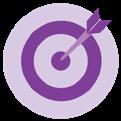
Learning aims
What learners should know at the end of the lesson according to CAPS requirements.
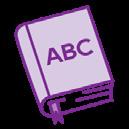
Definitions
Definitions of concepts to understand the content.

For the curious
Encouragement to do in-depth research about the content. Expand the activity and exercise to such an extent that learners are encouraged to explore. For gifted learners: expanded exercises. For Learners with Special Educational Needs (LSEN): explain the need to complete the basic questions to achieve a pass mark.

Activity
Questions to complete to test the learners’ knowledge of the completed lesson.

Core content
Emphasise the core of the content; in-depth explanation of a specific section of the lesson; learners must understand this content.
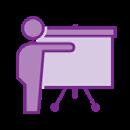
Exercise
To conclude the specific unit. Formative assessment.
SAMPLE
TERM 1
PHYSICAL EDUCATION, DEVELOPMENT OF THE SELF IN SOCIETY AND WORLD OF WORK
In this unit’s Physical Education, we will focus on general fitness. You will get the opportunity to participate in physical activities and to realise the benefit of exercise.
You must spend at least 10 hours per term doing physical activities. That is 40 hours in total for the year. Spend at least 1 hour per week doing physical activities. Always wear comfortable clothes and a good pair of training shoes. Exercise in a safe, spacious area like a park or a rugby field. Our physical health affects our emotional health, which is why Physical Education is a very important part of Life Orientation.
In this unit we will also focus on the formation of self-esteem and self-motivation. You will go through many emotional and physical changes during adolescence. It is important to build your self-esteem and to feel accepted by your peer group. This unit will help you develop additional life skills and emotional intelligence to manage challenges. Apply your new life skills to further develop your potential. This will enable you to successfully tackle life’s challenges. We will also discuss sexuality, relationships and friendships.
The world of work is another topic we will look at this term. We briefly revise the different learning styles and study methods we discussed in Grade 7, and then you will identify your own learning style so you can apply it to your own studies.
Work through the lessons at a comfortable pace. At the end of each lesson, you will find an activity to assess your understanding. Some questions in the activities will test your insight while others will require you to apply what you have learned.

Learning aims
At the end of this unit, you must be able to:
• recognise the safety issues for general fitness exercises and apply good judgement
• work out your own fitness programme and participate in it
• identify factors that affect the formation of self-esteem and self-motivation
• speak positively about yourself
• apply strategies and skills to develop your potential
• understand your sexuality
• understand your friends’ and peer group’s sexuality
• identify acceptable ways of beginning and ending friendships and relationships
• develop problem-solving skills
• develop communication skills
• identify different learning styles.
LESSON 1: GENERAL FITNESS

Definitions
• Aerobic exercise: Aerobic exercise (exercise requiring oxygen) is any type of cardiovascular conditioning. Your breathing controls the amount of oxygen in your blood that reaches your muscles to help you burn energy and move.
• Balance exercise: A type of exercise that strengthens all the muscles that help keep the body upright.
• Stretching exercise: An exercise that stretches the muscles and improves your range of motion in the joints.
• Resistance exercise: An exercise that causes the muscles to contract against an external resistance, such as your own body weight, gravity, resistance bands, weights or dumbbells, to improve muscle strength and endurance.
Exercise and general fitness are good for your body and mental health because it releases endorphins. Endorphins are chemicals found in the brain that help you feel good. They also help you manage tension, anxiety and depression. People who exercise are generally healthier and more relaxed.
Fitness activities safety precautions
Fitness comprises different components and your fitness programme should include all the components. The fitness components are:
1. Cardiovascular fitness (heart and blood vessels)
2. Muscle strength
3. Muscle endurance
4. Suppleness (warming up and cooling down)
5. Speed endurance
Base your fitness programme on the FITT principle. It is a terrific way to monitor your progress:
• Frequency: how many times a week you exercise.
• Intensity: how hard you exercise and how many repetitions of each exercise you do.
• Type: which component of fitness you are addressing, e.g. endurance.
• Time: the amount of time you spend on each exercise.
SAMPLE
Always consider your safety when exercising. Things to consider:
• Who you exercise with – exercise with your family, friends, neighbours or people with the same fitness goals.
• Where you exercise – choose a safe and pleasant environment to exercise, and avoid deserted areas. The area should be spacious.
• When you exercise – exercise early in the morning before school or late in the afternoon.
• Why you exercise – do you exercise to stay fit and healthy, or to lose weight?
• Your clothing – wear appropriate clothes and shoes for the exercise/activity.
• Your exercise equipment – use equipment that is appropriate for the activity and in a good condition.
It is important to always drink enough water and stay hydrated. Do not exercise when ill. Listen to your body –stop and rest if you experience pain or discomfort while exercising.
Warm up
Warm up thoroughly before exercising to prepare your body for exercise.
Warm up by jogging slowly for 5–10 minutes. This prepares your muscles, and increases your heart rate and body temperature. It also improves the way your body uses oxygen, increases your metabolism, and improves blood flow to the muscles and organs. Finish with 10–15 minutes of dynamic stretch exercises to reduce muscles stiffness.
There are two types of stretching exercises: static stretching and dynamic stretching. Static stretches are when you stretch a muscle and hold it in place for a few seconds, e.g. hamstring stretch, quad stretch, etc. Dynamic stretches are when your joints and muscles go through a full range of motion, e.g. jumping jacks, lunges, etc.
Consult a physiotherapist before doing dynamic stretch exercises, particularly if you are dealing with an injury or want to make sure you do the exercises correctly.
Warm-up exercises
1. Jog or briskly walk for 5–10 minutes. You can alternate jogging with walking if you are unfit.
2. Next, move on to dynamic stretching exercises for 10–15 minutes. Complete 10 repetitions of each exercise on each side. Extend the muscles gently, do not overextend, you should not experience any pain.
Neck
• Tilt your head slowly to the front and then slowly to the back. Repeat 10 times.
• Hold your head up straight. Look to your left and then straight ahead again. Look to your right and straight ahead again. Repeat 10 times to each side.
• Hold your head up straight and tilt your neck to the left so that your ear almost touches your left shoulder. Now tilt your neck to the right so that your ear almost touches your right shoulder. Repeat 10 times to each side.
Shoulders and arms
• Extend your left arm in front of you and grab hold of it with your right arm.
• Push your left arm back against your chest with your right arm.
• Hold the position for 10 seconds.
• Repeat 10 times with each arm.
• Stand up straight and keep your arms horizontal at your sides.
• Rotate your arms in small circular motions.
• Repeat 10 times to the front and 10 times to the back.
• Extend your arm over your head and bend your elbow so that it touches your back.
• Use your other hand to hold your elbow and pull it to the side until you feel a stretch in your arm.
• Do this with both arms. Hold for 10 seconds.
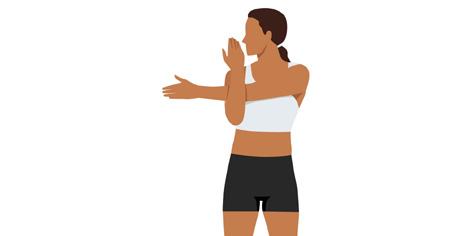
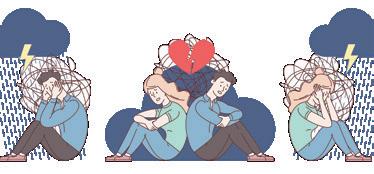
• Stand up straight with your shoulders relaxed.
• Raise both of your shoulders as high as you can, as if you were trying to touch them to your ears. Keep your head and neck still and relaxed. Hold for 5 seconds.
• Repeat 10 times.
Waist, torso and sides
• Stand up straight with your feet shoulder width apart.
• Bend down and touch your right foot with your left hand while extending your right arm upwards. Come right back up.
• Immediately switch to your right arm and touch your left foot while this time extending your left arm upwards. Come right back up.
• Repeat 10 times on each side.
• Start on the floor on your hands and knees in the push-up position, keeping your elbows and knees bent.
• Lift your right arm up and stretch it as far as possible. Return your arm to its original position.
• Repeat with your left arm. Return your arm to its original position.
• Repeat 10 times on each side.
Legs
• Stand up straight. Pull your right foot towards your buttocks.
• Hold the position for 10 seconds.
• Repeat with your other leg and hold the position for 10 seconds as well.
• Stand up straight.
• Place your left foot out in front of you and bend your knee at a 90° angle, while lowering your right leg behind you so that your knee touches the ground.
• Hold the position for 10 seconds.
• Now place your right foot out in front of you and repeat the previous steps on the other side.
• Repeat 10 times.
• Stand up straight. Extend your left arm out in front of you.
• Now kick your right leg up so that you touch your left hand.
• Repeat with you other leg and arm.
• Repeat 10 times with each leg.
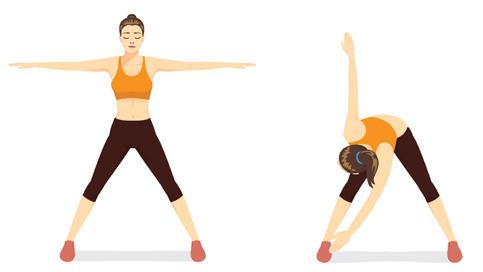
SAMPLE
• Sit on the floor with both legs stretched out in front of you.
• Bend one leg so that your foot touches the knee of the extended leg.
• Now reach forward as far as possible and grab hold of the foot of the extended leg.
• Pull your foot towards your body so that you feel a stretch in your leg.
• Hold the position for 10 seconds.
• Repeat with your other leg.
Ankles
• Point your toes up and then down.
• Repeat 10 times up and 10 times down for each foot.

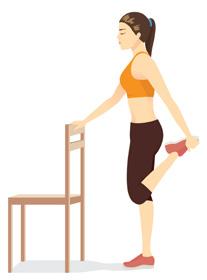
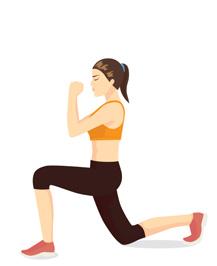
Cool down
Cool-down exercises are very important to lower your heart rate and normalise your breathing. This helps your body remove lactic acid, improves blood circulation and reduces adrenalin in the body. End your exercise session by walking or jogging for 5–10 minutes and stretching for 5–10 minutes to prevent muscle stiffness the next day.
Cool-down exercises
1. Start your cool-down session by gently jogging or walking for 5–10 minutes.
2. Stand in one place, interlock your fingers, raise your arms above your head and take a deep breath. Hold your breath for about 5 seconds, exhale and lower your arms. Repeat 10 times.
3. Move on to 5–10 minutes of static exercise. Extend the muscles gently, do not overextend, you should not experience any pain.
Legs
• Place your right foot out in front of you and while keeping your left leg behind you in a slightly bent position.
• Now press down on the bent leg and stretch forward.
• You should feel a stretch in your extended leg.
• Hold the position for 10 seconds.
• Repeat with the other leg.
• Stand up straight. Pull your right foot towards your buttocks.
• Hold this position for 10 seconds.
• Repeat with your other leg and hold the position for 10 seconds as well.
• Stand up straight.
• Place your left foot out in front of you and bend your knee at a 90° angle, while lowering your right leg behind you so that your knee touches the ground.
• Hold the position for 10 seconds.
• Now place your right foot out in front of you and repeat the previous steps on the other side.
• Repeat 10 times.
Full body
• Stand up straight with your feet comfortably apart and interlock your fingers above your head.
• Extend your arms above your head as far as possible.
• Hold the position as long as possible.
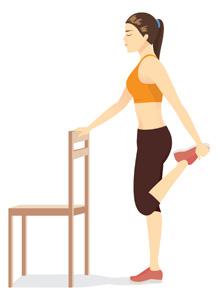

Your own fitness programme
This term, we will look at a fitness programme and help you develop one for yourself. At the end of this term, your facilitator will assess your participation in and execution of the activities.
To get the full benefits of a fitness programme, you must follow it for at least four weeks. After four weeks you can do more repetitions of the exercises and increase the time spent exercising. You will notice that you are fitter and stronger after the four weeks.
You should spend at least 1 hour per day on physical activities, 20 minutes of which should consist of warm-up and cool-down exercises.
Summary of the four main groups of exercises
Your programme should include the following exercises:
Endurance/aerobic
• Increases your breathing and heart rate.
• Keeps your circulatory system healthy.
Resistance/strength training
Balance
Flexibility
• Builds strong muscles.
• Improves bone density.
• Improves body awareness.
• Helps with coordination and to prevent falls.
• Improves your sports performance.
• Lowers your risk for injuries.
• Improves your ability to perform daily tasks.
• Your muscles generally work more efficiently.
• Walking
• Jogging
• Cycling
• Swimming
• Rock climbing
• Aerobic exercise
• Obstacle course exercises
• Martial arts (karate, boxing, judo, etc.)
• Skateboarding
• Jumping rope exercises
• Weightlifting
• Circuit training
• Resistance bands
• Stair climbing
• Gardening
• Standing on one leg
• Handstand
• Dancing
• Yoga
• Gymnastics
• Stretching exercises
• Yoga
Guidelines for a fitness programme
1. Choose activities you are interested in, that you would like to learn more about or that are in line with your fitness goals.
2. Decide how many days per week you will participate in the activities. You can choose any activity that will improve your fitness, such as jogging, rugby, netball, swimming, etc.
3. Decide what you will focus on each day, e.g. Mondays = aerobic exercises, Wednesdays = balance exercises and Fridays = flexibility exercises.
4. Try to do at least 1 hour of physical activity every day.
5. Always start with a warm-up routine.
6. Always end with a cool-down routine.
This is an example of how you could compile your fitness programme, but it remains your choice what activities you want to participate in this term.
Example of a fitness programme
MONDAY
Warm up Jog for 5 minutes.
Exercise
Jog at a medium pace for 10 minutes. Jog at a fast pace for 5 minutes.
Jog flat out for 1 minute.
Cool down Jog for 5 minutes.
Warm up
Swim 10 laps at a moderate pace. Warm up
for 10 minutes. Warm up
for 10 minutes.
Exercise
Swim 10 laps freestyle. Swim 10 laps backstroke.
Cool down
Swim 5 laps at a moderate pace.
Exercise
Play a weekly competitive sport against a friend.
Cool down Stretch for 10 minutes.
Rest
Exercise
Weekly dance lesson for an hour.
Cool down Walk around for 5 minutes.
LESSON 2: SELF-CONCEPT AND SELF-MOTIVATION

Definitions
• Goal: An aim or desired result, usually within a time frame.
• Individuality: The qualities that make you an individual. It differentiates you from others.
• Self-concept: The image you have of yourself.
• Self-motivation: Having the enthusiasm and drive to reach your goal.
• Unique: One of its kind.
How is your self-concept formed?
Your self-concept is the image you have of yourself. Some people think of themselves as pleasant, attractive, sporty or cool. Others have a negative image of themselves, which can influence their entire life. Other people may not see you as you see yourself. Several factors influence the formation of your self-concept and self-motivation:
• Your family. It feels good when your loved ones praise you and treat you well. However, if they criticise you often, you may feel that you are not good enough. It may give you a negative concept of yourself.
• Your friends. You spend most of your time with your friends and their opinion matters a lot in your teenage years. You want them to like and accept you. The way in which they treat you can either positively or negatively influence your self-concept.
• The media. Social media, advertisements and magazines often create a false impression of the meaning of success or popularity.
• Self-criticism. Comparing yourself to others can make you feel negative about yourself. Is your big nose all that you see or do you also notice your beautiful eyes?
• Your experiences. Everything you have experienced in the past, has a positive or negative influence on you. It determines how you perceive yourself.
• Your imagination. Thinking that you cannot do something may prevent you from trying in the first place. How will you ever know if you are able to do it?
• Unrealistic expectations. You may be struggling with one or two subjects, and think it must be because you are stupid. Is this really a realistic view of yourself?
Improve your self-concept
One way of improving your self-concept is by setting yourself goals. The following scenario is an example of someone setting himself a goal. You can also apply it to your own life. Siya is a talented rugby player. He excels at rugby and would like to play for the A team, which is why he works hard every day to reach his goal. He gets up early in the morning and runs 5 km. He also trains with his current team in the afternoons. He eats healthily and drinks plenty of water. Siya knows he must stay focused and disciplined to reach his goal. He knows he will not be able to play rugby forever, and that is why he plans to study sports management one day to follow a career in sport.
Let us discuss the steps Siya takes to reach his goal and thereby build a positive self-concept.
1. Siya identifies his talent:
• He excels at rugby.
2. How does Siya develop this talent?
SAMPLE
• He exercises and trains.
• He eats healthily.
• He receives professional coaching.
3. Siya sets himself a goal and a time frame for reaching his goal:
• He wants to be selected for the A team at the next trials.
4. Siya identifies his strengths that will help him reach his goal in a certain time frame:
• He is fit and strong.
• He has talent.
• He exercises and trains hard.
• He is focused.
You can apply these steps to your own life. You must be self-motivated to reach your goals. Determine your self-motivation by answering these questions:
1. Do you plan your day?
2. Do you usually follow your plan for your day?
3. Do you set yourself academic goals?
4. Are you easily distracted from your goal?
5. Do you often procrastinate?
6. Do you struggle doing things you do not enjoy?
If you answered YES to questions 1–3 and NO to questions 4–6, you are highly motivated. If not, you should work on your self-motivation.
Develop positivity
Positivity is a choice. You choose how you feel and what you think about. It may be difficult to stay positive when your circumstances are not positive, but it’s your choice how to handle it.
Positivity has many benefits:
• It is a scientific fact that positive people are healthier and live longer.
• Positive people are more successful at school and in their personal relationships.
• Positive people find solutions to problems faster.
Enjoying your life with your family and friends, doing well at school, and being good to others all contribute to a positive outlook on life. Positive people do not take things too seriously and they have a goal in life.
Pay attention to your emotions and how you feel about yourself: Do your emotions help you to reach your goals or do they get you down? You can choose to be more positive.
Identify your unique characteristics
Every person has a unique personality with unique characteristics. This makes you an individual. It is important that you know what your unique characteristics are and that you develop them. It will improve your performance. Answer these questions about yourself:
• Who am I?
• What do I like and what don’t I like?
• What are my strengths?
• What characteristics would I like to change?
• Do I surround myself with positive or negative people?
• What characteristics differentiate me from others?
SAMPLE
Reflect on your answers. Try and identify your unique characteristics and write them down.
Cultivate your potential
Your personal potential is your ability to reach a goal. It is deep within you; you are born with it. Everybody’s potential is different – one child in a family may have the potential to become a provincial athlete, while their sibling may have the musical potential to become a famous singer.
Identifying your talent and aptitude will give you a better idea of your potential. How do you identify it? Good self-knowledge and a good self-concept will help you identify and cultivate your potential.
The first step is to ask yourself: What am I good at? You may be a good swimmer. You represent a club and win all your events. Your coach thinks you could represent the national team someday. He thinks you have potential. Perhaps you are very good with your hands, you are skilful at making things and you can design or build anything – even machines. And academically, you are good at mathematics and science. You therefore have the potential to become an engineer.
Secondly, ask yourself: How do I cultivate my potential? You do that by setting achievable goals. If you are the swimmer, you will focus on your training and diet. You may get professional coaching. If you wanted to become the engineer, you would focus on your academic performance. You would try to improve your mathematics and science marks, and gather information about your interests.

Core content
Every person has a self-concept. Your self-concept determines your life and behaviour. It also affects your performance and chances of achieving success.
A person with a healthy self-concept also has self-love and accepts their own faults. They are positive and focus on their strengths. They admit to not liking all their characteristics, but choose to improve them instead of being negative.
Some people have a tough time accepting themselves. They have a negative self-concept and therefore cannot reach their full potential.
It is important to be positive and talk positively about yourself. It will help you achieve personal success and your goals.

For the curious
Research any celebrity who overcame personal setbacks to become successful. How did this person develop their potential?

SAMPLE
Activity 1
Make a collage of four things that affect your self-image. Focus on material things and not on people. It can be anything that affects you positively or negatively, like cell phones, clothes, cars, etc. Your collage must be half an A4 page. After finishing the collage, answer these questions:
1. What is your opinion of the items you used in the collage? Do you think you should allow these things to affect your self-image? Provide five statements that clearly explain your opinion. (5)
2. What do you think will happen if someone bases their happiness and self-image on material possessions? Name two consequences. (2)
3. Briefly explain your collage. Why did you choose these four things and in what way did each one affect your self-image? (8)
LESSON 3: CONCEPT: SEXUALITY

Definitions
• Peer pressure: The influence that other people of your age and social group have on you to be respected and accepted by them.
• Sexuality: The combined characteristics that make an individual male or female. This includes a person’s sexual life, feelings, needs and activities.
• Values: Beliefs about what is right and wrong, and what is important in life.
What is sexuality?
Your sexuality is the combined characteristics that make you male or female. This includes your sexual life, feelings, needs and activities. Your sexuality and gender awareness are still developing at this stage. Both your body and emotions will undergo changes, and you may not always understand your own feelings and behaviour. It is important that you build a good support system so that you always have someone you can talk to and share your feelings with.
Your thoughts and feelings regarding sex will determine how you approach and handle sexuality. Sex education will enable you to make informed decisions about your own sexuality.
Factors that influence sexuality
• Friends and peer pressure
Your friends have their own view on sexuality. Their views are formed by their parents, family, culture, religion and community. Your norms and values may be similar to your friends’ or completely different. Your friends may share inaccurate information with you that could skew your view on sexuality and lead you to make poor decisions.
Peer pressure also has an influence on your sexuality. You may end up in a social circle that encourages you to partake in certain sexual activities that you feel uncomfortable with. You may feel pressured into doing something just to fit in with the crowd.
SAMPLE
• Family and community
Your family is the first place where you learn about the roles of males and females. It is here where your values are formed. Factors such as divorce, abuse and your parents’ relationship with each other can influence your view of sexuality. You may witness a power struggle between your parents or get the idea that one gender may be treated as inferior. Studies have shown that teenagers who come from communities with a lower socio-economic status are more inclined to be promiscuous. This is because parents must often work long hours and children are thus left without supervision.
• Culture and religion
Sexual norms have changed with time. Diverse cultures also have different customs. In some cultures, the topic of sexuality is considered taboo, so parents do not discuss it with their children. Some religions forbid premarital sex and consider it a serious offence punishable by law. In other cultures, women are required to prove their fertility by having a baby before marriage.
• Social pressure and the media
Teenagers are exposed to the internet, social media, magazines, TV and radio every day. All these media influence you as a teenager. The media often use celebrities’ sexuality to convey a message and make their products seem more desirable. In your teens, role models help you to form your self-concept. The way in which a role model expresses their sexuality may influence your behaviour. Study these images of celebrities marketing fragrances:



What do you see first when you look at the advertisements? The product or the celebrity advertising the product? Advertisements are usually designed so that you will associate the product with the celebrity. That is because the marketer wants to create a desire within you to be just like that person, whether that be sexy, sporty or successful. They try to create the illusion that using the product will help you become like that celebrity. Their masculinity or femininity is used to influence you. What many teenagers do not realise, is that it is simply an illusion and very far removed from real life. That is why many people are disillusioned when they buy the product and realise they don’t feel the way the advertisement promised.
Problem-solving skills
SAMPLE
It is important that you have good problem-solving skills. It helps you form your identity and enhances your development as a person. We face problems every day. How we solve these problems, enhances our personal development. If you start trying to manage your problems maturely in your teenage years, you will be able to do it even better later on in life.
Follow these steps the next time you encounter a problem:
• If the problem looks too big, break it down into smaller steps. It is easier to manage it one step at a time.
• Ask advice from someone you trust.
• Set long-term goals to solve your problem.
• Decide how you are going to solve the problem – this is your action plan.
• Set your plan into motion to see if it is successful.

4: Relationships and friendships
Core content
It is important to learn about sexuality and the factors that influence your sexuality. You should have empathy with yourself and realise that the changes you are going through will help you develop into an adult. You must be able to identify the factors that influence your concept of sexuality and tell the difference between right and wrong. You must become a person with your own values and norms.
The media exposes you to different ideas about sex and the differences between the sexes. If you have a wholesome, positive view of your own sexuality, you will be able to use all the information to make informed decisions.

For the curious
Research how many celebrities you recognise in advertising campaigns. How much money do they earn doing this? Do you think they are being exploited, despite earning so much for these advertisements?

Activity 2
Choose any local or international TV series you like, e.g. Stranger Things, Skeem Saam or Suidooster. Paste or draw a picture of the series’ logo in your workbook.
In a short essay of 100–150 words, describe what influence this programme has on teenagers. Do you think the situations in the series are realistic? Do you and your friends relate to it? Your own interpretations and opinions are important. You must clearly convey how the media influences teenagers. (10) You will earn marks for the following:
1. Introduction
Content
Conclusion
LESSON 4: RELATIONSHIPS AND FRIENDSHIPS

SAMPLE
Definitions
• Empathy: The ability to understand the feelings of another.
• Relationship: The interaction between two people.
Appropriate ways to initiate a relationship
In your teenage years, relationships have a great impact on your social life. Your friends may become involved in romantic relationships, but you should only start a romantic relationship when you feel ready. Perhaps you are perfectly happy to just have a group of friends.
The basis of a good relationship is honesty, respect and trust. These are the qualities you should look for in a friend. It does not matter what the person looks like or what kind of clothes they wear. Nobody is perfect. You
home classroom college workplace

